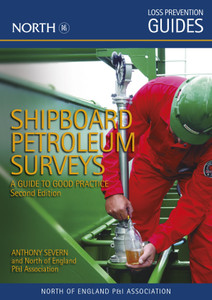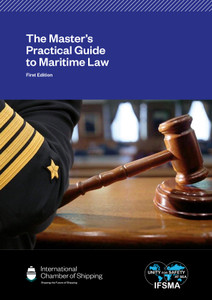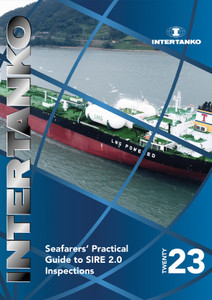
A Practical Guide to Shipboard Inspections - First Edition
'A Practical Guide to Shipboard Inspections' helps shipping companies implement a systematic approach to inspections, better comply with industry regulations and ensure their ships navigate the seas safely and in a manner that protects the marine environment. The recommendations in this guide are relevant to all ship types.
This first edition helps ship's officers, crews and superintendents prepare for all types of inspections and understand how they interlink; including flag state, port state control, class and masters' inspections. Firsthand tips from inspectors and a range of checklists are provided to help ship's crew prepare for, conduct and close out inspections.
All ship types across the industry are subject to various kinds of inspections' from flag state checking that ships comply with international and national standards to third-party inspections requested by charterers. Preparing for these inspections helps shipping companies ensure their ships navigate the seas safely, on schedule and in a manner that protects the marine environment.
A Practical Guide to Shipboard Inspections is a comprehensive guide to implementing a systematic approach to inspections for all ship types. From the moment an inspector boards through to the filing of the inspection report, this first edition walks readers through each stage of more than seven different kinds of inspections, including:
- Port state
- Flag state
- Class
- Port health
- Masters
- ITF inspections and more.
Developed using extensive interviews with current inspectors, this guide helps officers, crews and superintendents better understand how to:
- Work effectively with inspectors and surveyors
- Prepare for each type of inspection
- Identify what aspects of their ship needs further improvement before an inspection
- Dispute deficiencies in an appeals process and
- Deal with corruption during an inspection.
A Practical Guide to Shipboard Inspections not only collects the most common deficiencies across port state control regimes in one place but also suggests what specific actions ships should take to help reduce these deficiencies. A chapter on masters' inspections details the weekly checks to help spot potential findings and close them out before other inspections. Firsthand tips from inspectors and practical checklists for port state control, flag state, class and masters' inspections are also provided to help ensure each and every on board inspection goes smoothly.
Global health emergencies test our resilience, adaptability and capacity to thrive. The maritime industry did not stop operating during the Covid-19 pandemic despite the world's disrupted economies and strained healthcare systems.
It is essential for the maritime industry to continue operating through any global health emergency, ensuring that goods and services are brought to those that require them. To do so, shipping companies must have the necessary knowledge, tools and strategies ahead of these crises. This preparation enables the entire industry to properly plan for, respond to and recover from a global health emergency.
The Global Health Emergency Guide offers comprehensive guidance that covers all aspects of crisis management, including the early signs of an emerging global health emergency, ensuring necessary resources reach ships, safeguarding persons on board and the importance of communication between all stakeholders.
The Global Health Emergency Guide is divided into three parts:
- Part 1: Preparations for a future global health emergency;
- Part 2: Actions during a global health emergency; and
- Part 3: Recovery after a global health emergency.
Each part is further divided into chapters specific to shore-side staff, seafarers and toolkits containing useful checklists, templates and posters. The intention of this Guide's organisation is as follows:
- Part 1 should be reviewed during normal operations and this guidance should be considered for inclusion in the company?s Safety Management System (SMS);
- Part 2 should be reviewed and implemented into operating procedures during a global health emergency, as appropriate, so that the ship can maintain operations and keep seafarers safe; and
- Part 3 should be reviewed after a global health emergency to help the company assess what went well when handling the emergency and what needs improvement.
A standalone chapter is dedicated to seafarer health and wellness to highlight the strain that global health emergencies place on individuals.
In writing this Guide, a review group was formed of medical professionals, shipping company representatives and other maritime NGO employees. These representatives considered how to plan for a global health emergency where the symptoms, transmission method, effects or treatments are unknown. Drawing from the invaluable lessons learned from the Covid-19 pandemic and other global health emergencies, such as SARS, Ebola and Zika virus, this ICS Guide highlights trends from these crises and the actions taken by different stakeholders, including what worked well and what required improvement.
Some information is duplicated between chapters, to help readers who might read one section in isolation, rather than read the entire Guide from first page to last.
Acknowledgements
ICS extends its grateful thanks to the following organisations for their assistance in reviewing this publication:
- Cruise Lines International Association (CLIA)
- International Association of Dry Cargo Shipowners (INTERCARGO)
- International Christian Maritime Association (ICMA)
- International Maritime Health Association (IMHA)
- UK Chamber of Shipping
- Union of Greek Shipowners
Thanks are also extended to our industry partners who worked with ICS to produce dozens of free guidelines during the Covid-19 crisis and other global health emergencies, from which this new ICS Guide draws much of its source material.
Abbreviations
Definitions
Editorial notes
1 Overview of global health emergencies
1.1 What is a global health emergency?
1.2 Lessons learned from previous health emergencies
1.3 The new normal for the shipping industry
1.3.1 Treating seafarers as key workers
1.3.2 Digitalisation
1.4 The WHO International Health Regulations 2005
1.5 Pandemics, the IMO MLC, and the WHO International Health Regulations 2005
1.5.1 Comparisons between the MLC and the WHO International Health Regulations 2005
1.5.2 Member states' responsibilities under the MLC for global health emergencies
1.5.3 Company responsibilities under the MLC for global health emergencies
2 Seafarer health and wellness
2.1 Sanitary etiquette on board
2.1.1 Hand washing
2.1.2 Coughs and sneezes
2.1.3 Good hygiene measures while travelling
2.2 Seafarers' mental health
2.2.1 Employers' responsibilities for mental health
2.2.2 Offering and providing support
2.2.3 Organisations which can offer support
PART 1: Preparations for a future global health emergency
3 Shore-side preparation
3.1 Crisis management planning
3.2 Reviewing policies in the SMS
3.3 Keeping ship and shore personnel safe
3.3.1 The SMS and infection control
3.3.2 Shore-based service providers and infection control
3.4 Pre=joining checks
3.4.1 Crewing agent and/or employer responsibilities
3.4.2 Shipowner responsibilities
3.4.3 Seafarer responsibilities
3.5 Safe seafarer travel
3.5.1 Booking crew travel
3.5.2 Guidance for seafarers when travelling
3.6 Crew change templates
3.6.1 Crew change travel templates
3.6.2 Port travel templates for crew changes
3.7 Ship sanitation certificates
3.7.1 Port authority responsibilities
3.8 Crisis communications strategy
3.9 Social media policy
3.10 Establishing procedures for contacting the seafarer's designated contact in an emergency
4 Shipboard preparation
4.1 Measures to reduce risks on board
4.1.1 Ship sanitation certificates and inspections
4.1.2 Staying safe while travelling
4.1.3 Embarkation of crew and passengers
4.1.4 Hygiene measures to be adopted on board
4.1.5 Medical equipment to be kept on board
4.1.6 Disembarkation of crew and passengers
4.2 Seafarer vaccination checks
4.3 Keeping ship and shore personnel safe
4.3.1 The ship and shore interface
4.4 Care when ashore
4.4.1 Seafarers' centres
4.4.2 Good hygiene practices ashore
5 Pre-global health emergency toolkit
Form 5A Medical equipment to be carried on board checklist
Form 5B Screening questionnaire prior to boarding template
Form 5C Employer letter template
Form 5D Crew change and travel information template
Form 5E Seafarer designated contact template
Form 5F Pre-arrival checklist
Form 5G Documentation to be sent before a ship sanitation inspection checklist
Form 5H Example of a shipboard infection control standard operating procedure
Form 5I Template of ship sanitation control exemption certificate / ship sanitation control certificate
Form 5J Maritime declaration of health template
Form 5K Crew health declaration for port entry template
Form 5L Daily crew temperature check template
Form 5M Poster on how to wash your hands
Form 5N Poster on how to cope with stress during an outbreak
Form 5O Poster of safe travel procedures for seafarers during an outbreak
Form 5P Poster on how to protect yourself and others after coughing or sneezing during an outbreak
Form 5Q Poster on dealing with laundry of infected or non-infected crew or passengers during an outbreak
Form 5R Poster of good hygiene practices when greeting others during an outbreak
PART 2: Actions during a global health emergency
6 Shore-side actions
6.1 The WHO International Health Regulations 2005 and how they can affect shipping
6.2 Responsibilities in the event of an outbreak
6.2.1 Ensuring clearance is received
6.3 Procedures in the event of an outbreak at sea
6.4 Procedures in the event of an outbreak in port
6.4.1 Maritime declaration of health
6.4.2 Considerations by the port authority for seafarer shore leave
6.4.3 Considerations by the shipowner for seafarer shore leave
6.5 Managing safe crew changes
6.5.1 Requirements of shipping companies arranging seafarer travel
6.6 Managing ship and seafarer documentation
6.7 Crew member vaccinations
6.7.1 Considerations for vaccinating crew
6.7.2 Legal liability and insurance issues arising from vaccination of seafarers
6.8 Sick crew members and passengers
6.8.1 Isolation of sick crew members and passengers
6.8.2 Medical treatment in port
6.8.3 Repatriation
6.9 Internal communications during an outbreak
6.10 Media relations during an outbreak
6.10.1 Communications with the press
6.10.2 Use of social media
6.11 Informing the designated contact
6.11.1 Making contact
6.12 Deaths on board
6.12.1 Contacting the designated contact
6.13 Protocols to prevent seafarer abandonments
6.13.1 Shipowner obligations
6.13.2 Port state obligations
6.13.3 Flag state obligations
6.13.4 Labour supply states
7 Shipboard actions
7.1 Procedures in the event of an outbreak
7.1.1 Port entry restrictions
7.1.2 Transiting ships
7.1.3 Outbreaks in port
7.2 Keeping safe on board
7.2.1 Managing the ship/shore interface during an outbreak
7.3 Accessing medical care in port
7.3.1 Medical care in port
7.3.2 Medical repatriation
7.4 Protocols for joining and leaving a ship
7.5 Isolation of crew members on joining the ship
7.6 Decision making for on board or confirmed case
7.7 Care of sick crew and passengers during an outbreak
7.7.1 Patient care
7.7.2 PPE for crew members dealing with infected people
7.7.3 Dealing with contaminated laundry and furnishings
7.7.4 Dealing with contaminated hard surfaces
7.7.5 Identification of contacts
7.8 Crew member mental health during an outbreak
7.9 Sector-specific guidance
7.9.1 Tankers
7.9.2 Cruise ships
7.9.3 Offshore industry
7.10 Deaths on board
7.10.1 Establishing a cause of death
7.10.2 Procedure after a death on board
7.10.3 Storing a body until disembarkation in port
7.10.4 Family and crew concerns
7.10.5 Religious practices
8 During a global health emergency toolkit
Form 8A Considerations before any internal or external communications are released
Form 8B Informing the designated contact checklist
Form 8C Deaths on board checklist
Form 8D Crew health declaration template
Form 8E Daily crew temperature check template
Form 8F First call or visit template
Form 8G Employer letter template
Form 8H Second and subsequent call or visit template
Form 8I Designated contact call log template
Form 8J Bridge and accommodation disinfection list for pilot and/or visitor embarkation and disembarkation
Form 8K Dead body comments template
Form 8L Preparing a dead body for storage checklist
Form 8M Measures to support mental wellbeing during an outbreak
Form 8N Poster on how to cope with stress during an outbreak
Form 8O Poster of suicide warning signs
PART 3: Recovery after a global health emergency
9 Getting shipping operations back to normal
9.1 Re-assessing protocols and lessons learned
9.1.1 Assessing protocols for shipping companies
9.1.2 Assessing protocols on board
9.2 Helping employees get 'back to normal'
9.3 Managing safe interactions after an outbreak
9.3.1 Managing safe interactions on the ship
9.3.2 Managing safe travel
9.3.3 Managing safe interactions in the office
9.4 Employee assistance programmes
9.5 Follow ups and replenishing supplies
9.6 The impact on seafarer education and training
9.6.1 The impact on academic schedules
9.6.2 The impact on cadet berths and on board training
10 Post-global health emergency toolkit
Form 10A Managing safe interactions on board checklist
Form 10B Managing safe travel checklist
Form 10C Managing safe interactions in the office checklist
Form 10D Example of a company sickness and absence policy
Form 10E Return to work survey template
Form 10F Recruitment poster for a career at sea
References
The International Chamber of Shipping (ICS) is the principal international trade association for the shipping industry, representing shipowners and operators in all sectors and trades. ICS membership comprises national shipowners' associations in Asia, Europe and the Americas whose member shipping companies operate over 80% of the world's merchant tonnage.
Established in 1921, ICS is concerned with all technical, legal, employment affairs and policy issues that may affect international shipping.
ICS represents shipowners with the various intergovernmental regulatory bodies that impact on shipping, including the International Maritime Organization.
ICS also develops best practices and guidance, including a wide range of publications and free resources that are used by ship operators globally.
https://www.ics-shipping.org/about-ics/
- Number of Pages:
- 160
- ISBN:
- 9781913997625
- Published Date:
- July 2024
- Book Height:
- 210 mm
- Book Width:
- 150 mm
- Publication Date:
- July 2024
- Author:
ICS





